Tesla’s Navigate on Autopilot was my CES road trip companion
Robot is my co-pilot.
I love a good road trip. I've spent hundreds of thousands of miles in cars during my life, and the best times were when I knew it would be hours or even days before I reached my destination. Typically a friend (or friends) or family members would accompany me, but on a few occasions, it was just me, my music collection -- and scenery screaming past me at 70 miles per hour. In the past few years, more and more automakers have created semiautonomous systems so that you're no longer "alone" on these drives. One of the more robust (and most famous) is Tesla's Autopilot. It's a combination of lane-keep assist and tracking coupled with adaptive cruise control. It's impressive, and recently the automaker (also a battery and solar-panel company) updated the system to optimize your lane location and auto change lanes. So I took the latest upgrade; Navigate on Autopilot (available for Teslas built on or after October 19, 2016) on a 571-mile drive from San Francisco to Las Vegas to attend CES. Long drives, while fun, are exhausting. With that in mind, I got up at 5:30 AM and was on the road before 6:30 AM. Right off the bat, the difference between Autopilot and Navigate on Autopilot was apparent. I had used the system very briefly in L.A., but when you're looking down the hood of a car for at least 10 hours (but probably longer because of charging), you quickly notice how something will make the drive easier. Tesla says the system finds the quickest lane along your route. For example, if you're sitting in the right lane behind a slow-moving vehicle and the car determines that the left lane is moving faster (within your set speed limit), it'll prompt you to change lanes. You tap the indicator stalk and the car moves over when safe. During the drive, I followed the car's advice on which lane to occupy about 90 percent of the time. It was typically spot-on. It prompted me to switch lanes, I tapped the stalk in that direction and when safe, the car would move over. As a strong believer that the leftmost lane is for passing only, I was delighted that after overtaking a slower vehicle on the highway, the system prompted me to get back in the right lane, which I was happy to initiate. If we can teach a robot how to drive on the freeway, maybe there's a chance we can instruct the humans who think that hanging out in the left lane is OK to stop doing that. Seriously, stop doing that. You're impeding traffic. Currently, the system requires input from the driver to switch lanes by enabling the turn signal. But Tesla says that eventually, it'll give drivers the opportunity to opt out of instigating the lane change and letting the vehicle do it itself. During my drive, the actual lane-changing was far smoother than what I experienced in previous versions of Autopilot. But there were a few times when it pulled out in front of someone I would have waited to pass me. It wasn't cutting people off per se, but I'm sure some of the more aggressive drivers were not happy when I slid into their lane. Sorry, guy in the white Honda Accord. While the drive down Interstate 5 is pretty much a straight shot, I pulled off to charge, grab food and, of course, encountered a few interchanges. Navigate on Autopilot is built to tackle these tricky situations. Every time I was supposed to exit the interstate, the car prompted me to make sure it was in the right lane, then just before the exit, the turn signal came on and the car pulled off the freeway. Navigate on Autopilot is geofenced to highways and freeways without cross traffic, so as I exited the interstate, the system would give me a countdown of when Navigate on Autopilot would turn off and go back to just regular Autopilot. It does the same for interchanges. It recommends the correct lane, turns on the signal and then pulls off the main road. When you're traveling unfamiliar roads, interchanges and off-ramps can be a one-way ticket to an argument with your passengers when one is missed. Everyone should have been paying attention and yet, no one was. Navigate on Autopilot exited every time it was supposed too. I'm not saying it'll stop in-car fights, but it might help. But it's not a perfect system. It had a bit of a hiccup pulling off the freeway (this was later, while driving around Vegas during CES). It seemed like it wasn't sure where exactly where to pull off. So I just took over. The auto lane change also had a weird issue along a stretch of road in the desert. It would start to change lanes, then veer back into the original lane. Typically I can figure out why the system is having trouble: the contrast between the road and markings isn't drastic enough, the sun is shining directly into the sensors or any number of other factors. But here, I couldn't figure it out. About 5 to 7 miles down the road, the car went back to happily changing lanes on its own. Which brings me to my reminder that these systems still require hands on the wheel and for the driver to pay attention to the road. This is not an autonomous car. Semiautonomous, sure. But it's not self-driving, and we still have a ways to go before that's something any of us will be driving. Yet, during my road trip (which took 13 hours because I visited my mom and stopped four times to charge), Navigate on Autopilot was a helpful travel companion. It's not perfect, but it definitely made those 571 miles less taxing. I arrived in Las Vegas a bit tired but not nearly as exhausted as I would typically have been after being on the road for that long. Navigate on Autopilot is a substantial upgrade to Autopilot, which is what we're looking for as we (very) slowly move toward full autonomy. Road trips just got easier, but in no way less fun. You can still tackle the twisties or divert to side roads to gawk at roadside attractions that the highway system overlooks. But when you're on the interstate (or even commuting), Tesla has a system that'll help you get around. It's not a self-driving machine, but more like a companion that doesn't yell at you about eating all the jerky and knows exactly when the off-ramp is coming up.





